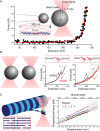Optical Tweezers Approaches for Probing Multiscale Protein Mechanics and Assembly
- PMID: 33134316
- PMCID: PMC7573139
- DOI: 10.3389/fmolb.2020.577314
Optical Tweezers Approaches for Probing Multiscale Protein Mechanics and Assembly
Abstract
Multi-step assembly of individual protein building blocks is key to the formation of essential higher-order structures inside and outside of cells. Optical tweezers is a technique well suited to investigate the mechanics and dynamics of these structures at a variety of size scales. In this mini-review, we highlight experiments that have used optical tweezers to investigate protein assembly and mechanics, with a focus on the extracellular matrix protein collagen. These examples demonstrate how optical tweezers can be used to study mechanics across length scales, ranging from the single-molecule level to fibrils to protein networks. We discuss challenges in experimental design and interpretation, opportunities for integration with other experimental modalities, and applications of optical tweezers to current questions in protein mechanics and assembly.
Keywords: collagen; fibrillar proteins; microrheology; optical tweezers (OT); protein assemblies; protein mechanics; protein structure/folding; single molecule.
Copyright © 2020 Lehmann, Shayegan, Blab and Forde.
Figures


Similar articles
-
Optical Tweezers Microrheology: From the Basics to Advanced Techniques and Applications.ACS Macro Lett. 2018 Aug 21;7(8):968-975. doi: 10.1021/acsmacrolett.8b00498. Epub 2018 Aug 5. ACS Macro Lett. 2018. PMID: 35650960 Free PMC article.
-
High-resolution optical tweezers for single-molecule manipulation.Yale J Biol Med. 2013 Sep 20;86(3):367-83. eCollection 2013 Sep. Yale J Biol Med. 2013. PMID: 24058311 Free PMC article. Review.
-
Determining the structure-mechanics relationships of dense microtubule networks with confocal microscopy and magnetic tweezers-based microrheology.Methods Cell Biol. 2013;115:75-96. doi: 10.1016/B978-0-12-407757-7.00006-2. Methods Cell Biol. 2013. PMID: 23973067
-
Probing the structural dynamics of proteins and nucleic acids with optical tweezers.Curr Opin Struct Biol. 2015 Oct;34:43-51. doi: 10.1016/j.sbi.2015.06.006. Epub 2015 Jul 17. Curr Opin Struct Biol. 2015. PMID: 26189090 Free PMC article. Review.
-
Bio-Molecular Applications of Recent Developments in Optical Tweezers.Biomolecules. 2019 Jan 11;9(1):23. doi: 10.3390/biom9010023. Biomolecules. 2019. PMID: 30641944 Free PMC article. Review.
Cited by
-
Advanced imaging techniques for studying protein phase separation in living cells and at single-molecule level.Curr Opin Chem Biol. 2023 Oct;76:102371. doi: 10.1016/j.cbpa.2023.102371. Epub 2023 Jul 29. Curr Opin Chem Biol. 2023. PMID: 37523989 Free PMC article. Review.
-
Determining Trap Compliances, Microsphere Size Variations, and Response Linearities in Single DNA Molecule Elasticity Measurements with Optical Tweezers.Front Mol Biosci. 2021 Mar 22;8:605102. doi: 10.3389/fmolb.2021.605102. eCollection 2021. Front Mol Biosci. 2021. PMID: 33829038 Free PMC article.
-
A fit-less approach to the elasticity of the handles in optical tweezers experiments.Eur Biophys J. 2022 Jul;51(4-5):413-418. doi: 10.1007/s00249-022-01603-2. Epub 2022 May 23. Eur Biophys J. 2022. PMID: 35599262
-
Mechanical Behavior of Octopus Egg Tethers Composed of Topologically Constrained, Tandemly Repeated EGF Domains.Biomacromolecules. 2023 Jul 10;24(7):3032-3042. doi: 10.1021/acs.biomac.3c00088. Epub 2023 Jun 9. Biomacromolecules. 2023. PMID: 37294315 Free PMC article.
-
Modeling the extracellular matrix in cell migration and morphogenesis: a guide for the curious biologist.Front Cell Dev Biol. 2024 Mar 1;12:1354132. doi: 10.3389/fcell.2024.1354132. eCollection 2024. Front Cell Dev Biol. 2024. PMID: 38495620 Free PMC article. Review.
References
Publication types
LinkOut - more resources
Full Text Sources

